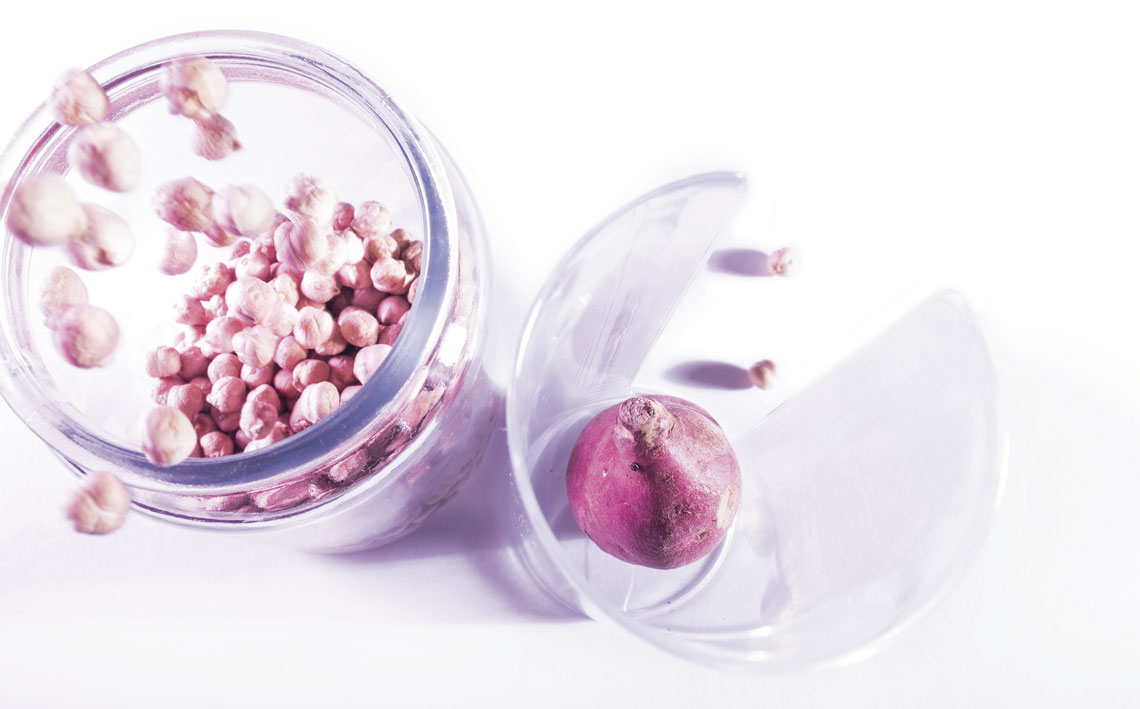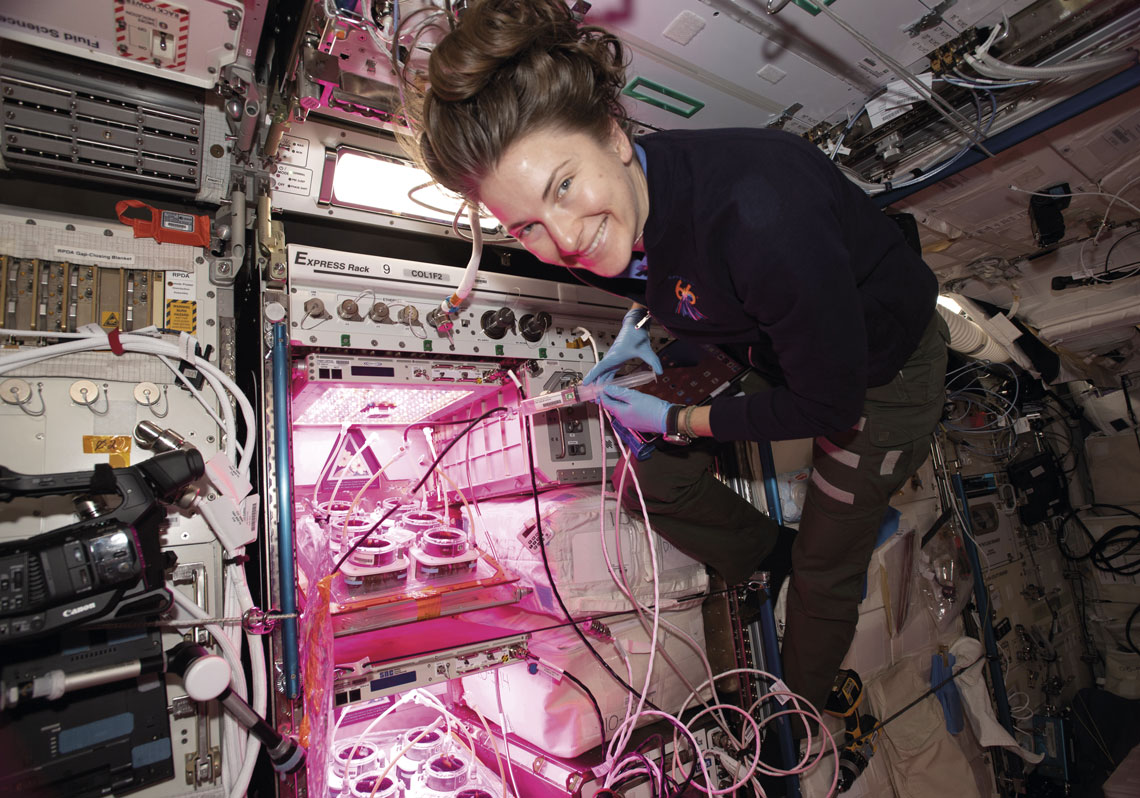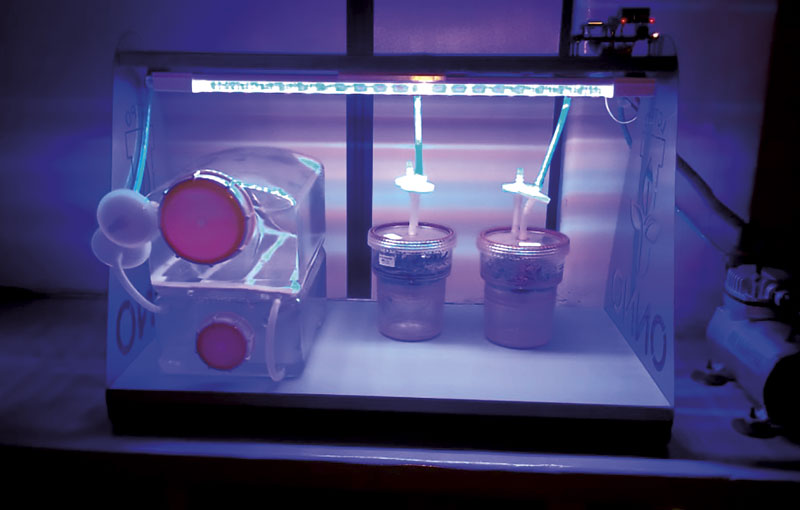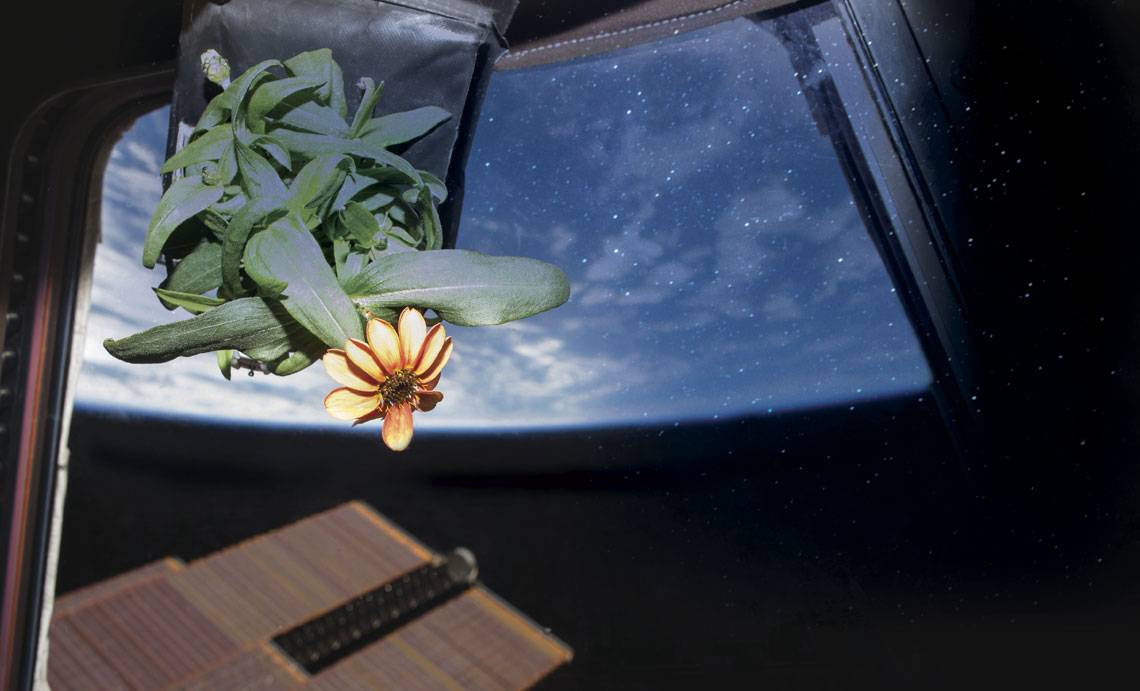Forty Brazilian researchers from 13 institutions formed an informal network with the aim of advancing a field little explored in the country: space agriculture. The project was given extra impetus in September 2023, when the Brazilian Agricultural Research Corporation (EMBRAPA) and the Brazilian Space Agency (AEB) signed a memorandum of intent to focus on growing plants in space, creating an opportunity for Brazil to contribute to NASA’s Artemis program. One of the aims of the initiative is to build a base on the Moon as a first step towards a future manned mission to Mars. In a new space race with China as its main adversary, the US published the Artemis Accords in 2020, setting out general guidelines for international cooperation in the peaceful exploration of space. Brazil joined the agreement almost three years ago, and it has now been signed by 36 nations.
One of the major challenges of long-term space missions is the production of fresh food, whether it be in space stations and spacecraft, on the Moon, or even on Mars. Several international projects are attempting to develop prototypes of lunar and Martian greenhouses. Research by NASA has helped improve the use of LED lights for agriculture in controlled environments and the structure of vertical farms, currently used in urban environments (see Pesquisa FAPESP issue nº 310).
At the International Space Station (ISS), operated by the American, European, Canadian, Japanese, and Russian space agencies, astronauts eat lettuce, Chinese cabbage, radishes, tomatoes, chard, and other vegetables grown in chambers on two platforms developed by NASA: the Vegetable Production System (Veggie) and the Advanced Plant Habitat (APH). A third platform, Ohalo III, is currently under development at the Kennedy Space Center in Florida, USA.
Now, Brazilian groups want to use their expertise to contribute to this field. “Brazil is internationally recognized for its agricultural research and there is no reason not to participate in Artemis, a field of study in which we are very strong,” says agricultural engineer Alessandra Fávero, a researcher at EMBRAPA Southeast Livestock in São Carlos, São Paulo, and leader of the initiative.

Léo Ramos Chaves / Revista Pesquisa FAPESPVertical farm by São Paulo–based company Pink Farms: NASA research helped improve the use of LED lights at the farmLéo Ramos Chaves / Revista Pesquisa FAPESP
“Our plan is to work on a technological package with two plant models: sweet potatoes and chickpeas. We want to develop cultivars that are better adapted to challenging situations, such as closed environments, microgravity, and cosmic radiation.” Earth’s atmosphere protects plants and animals from the various types of ionizing radiation present in space. The consequences of intense exposure without this protection, such as possible mutagenic effects on plants, need to be studied further.
Fávero believes the plants and systems the team plans to develop could be used in space stations, on the Moon, and potentially on Earth. “Not just in urban vertical farms, but in any other situation associated with climate change, where water or light is less available,” he suggests.
The two plant models were chosen after a year of discussion between the researchers, before the agreement between EMBRAPA and the AEB was signed in 2023. “Taking food from Earth to an extraterrestrial colony or on a very long space mission is extremely expensive. And storage space is a premium,” emphasizes Gustavo Maia, a biologist from the Federal University of Pelotas (UFPel) in Rio Grande do Sul, one of the members of the new network. Maia points out that nutritional factors will be essential to future colonizers. “There certainly won’t be many cultures. That’s why we chose sweet potatoes, which are high in carbohydrate, and chickpeas, which contain a lot of protein.”
According to the biologist, the fact that Brazil has a large germplasm bank of these crops also heavily influenced the choice of the two vegetables. “One of the major challenges of agriculture in space is the mutagenic effect [changing of the plant’s DNA] caused by cosmic radiation. We are going to subject a wide range of genetic material to this radiation to identify the most tolerant plants.”

Léo Ramos Chaves / Revista Pesquisa FAPESPEMBRAPA intends to develop new chickpea and sweet potato cultivars adapted to the microgravity environment of spaceLéo Ramos Chaves / Revista Pesquisa FAPESP
Another limitation to growing crops in space is the absence of any abundant source of water, oxygen, and nutrients. To overcome this, the researchers will need to select plants that make highly efficient use of water, light, nitrogen, and other nutrients. One of the issues is determining the ideal substrate for the plants to grow. “Because lunar soil is very nutrient-poor, we considered hydroponics [cultivation in water], aeroponics [with plant roots suspended in the air], and even fertilization with microorganisms or organic matter,” explains the UFPel researcher, who specializes in the physiology of stress in plants. There are no answers yet. “One thing is certain: the cultivars must not demand too many nutrients.”
Maia, who is head of UFPel’s Plant Cognition and Electrophysiology Laboratory, normally uses soybeans as a model in his experiments. His role in the space agriculture project will be to establish physiological parameters that explain how plants might behave in the restrictive conditions of space, thus helping the team select the most suitable genetic materials. The group will also attempt to develop a plant-computer interface for real-time remote crop monitoring, diagnosis of problems using AI, and automatic crop management.
“The aim is for the plant itself to adjust to the environment, without direct human interference,” explains Maia. “We already have a prototype with sensors that collect bioelectrical signals from plants, a bit like an electrocardiogram. These data can be used to determine the physiological state of the plant. We then know if it is lacking water and nutrients or if it is diseased,” he explains. With the future plant-computer interface, researchers will be able to intervene remotely in space, solving problems without the need for an astronaut to handle crops directly.
In an article published in the journal Frontiers in Sustainable Food Systems in 2021, Maia’s team showed how internal communication occurs in plants in response to stress. In the experiment described in the paper, they detected electrical signals sent by the fruit (in this case, tomatoes) to the rest of the plant when attacked by caterpillars.
The researchers put electrodes on the stems of the tomato plants and noticed differences in the electrical activity of fruits that suffered damage. Changes were also identified in biochemical analyses of the fruits and leaves of attacked plants. “We cannot make a direct association between the electrical signal generated in the fruit and the observed response, but it is likely that this is linked to other established forms of herbivory-induced signaling [based on an animal attack],” write the authors in the text. They concluded that the study “can contribute to more sustainable harvesting and food production.”

Nasa Johnson Space CenterAstronaut Kayla Barron works on an experiment by the Veggie project in spaceNasa Johnson Space Center
Experiments in space
Some of the experiments by the newly formed Brazilian network will take place in universities and research centers using equipment such as an adapted clinostat (a device that simulates the conditions of low or no gravity). The scientists are also planning for experiments to be carried out on the ISS or on a spacecraft outside Earth at some point in the future.
To this end, they can count on the experience of Wagner Vendrame, an agricultural engineer from the Environmental Horticulture Department at the University of Florida who is also part of the network. Specializing in the production and conservation of ornamental plants using cryopreservation and micropropagation, Vendrame has sent five experiments into space in collaboration with NASA since 2007.
Four of them involved the flowering plant Jatropha. “We wanted to see how microgravity affected the expression of certain genes. We demonstrated that some are activated, some are more expressed, and others are repressed. Some of the changes were permanent,” explains Vendrame, who earned his degree at the University of São Paulo (USP). “Upon arriving in space, the plant realizes that it is in a stressful environment and begins to turn ‘switches’ on and off in an attempt to achieve a balance and survive. It starts to produce proteins related to abiotic stress, which in this case is a lack of gravity and radiation. In the end, it becomes more stress-tolerant.”
Anticipating new studies on Jatropha and microgravity, Vendrame and his colleagues sequenced and annotated possible markers in the plant’s genome. “The microgravity environment has unique characteristics that allow studies of its effects on plant cell structure and physiology,” said Vendrame and colleagues in an article published in the International Journal of Genomics in 2017. “Microgravity-induced mutations could be explored as a new approach to plant breeding by combining space biology with agricultural breeding technology,” the authors wrote.
In his first experiment in partnership with NASA, Vendrame sent cells of white ipê, royal poinciana, orchid, and thale cress — one of the most used plant species in scientific research — to the international station. “We noticed that in the microgravity environment of space, the cells tend to come together and form a three-dimensional structure, while here on Earth they spread out in a more two-dimensional pattern,” says Vendrame.

LCTPO-ESALQ-USPIn vitro cultivation under blue light in a USP laboratory; the aim is to lower the plant’s metabolismLCTPO-ESALQ-USP
The scientists started from the idea that these cells are similar to human stem cells, since they have all the genetic information needed to generate an entire plant rather than just a part of it, such as the root or the part above ground. “We wanted to use plant cells, which are easier to manipulate, to demonstrate the concept that cells grow in a more three-dimensional shape in space,” he says. According to the agricultural engineer, this could be useful in the future for cultivating human organs for transplants by growing cells in space.
Another Brazilian who studies ornamental plants and will participate in the space agriculture research is Paulo Hercílio Viegas Rodrigues, an agricultural engineer from USP’s Luiz de Queiroz College of Agriculture (ESALQ). In 2021, Rodrigues led a team attempting to produce fresh food in an area of two cubic meters for a hypothetical trip to Mars, part of an international challenge set by NASA and the Canadian Space Agency.
The group used data from three ongoing studies: one on how the blue light spectrum affects crops grown in vitro, which reduces the metabolism of certain plants and has antioxidant properties; another on strawberry production in vertical indoor gardens; and the third on D-limonene, a biodegradable solvent with fungicidal and insecticidal characteristics that also increases a plant’s carotenoid content.
The project, which used strawberry and taioba, was named one of the 10 best in the competition. “Our compact germplasm bank, a device we created to test different light spectrums on taioba, will be patented,” says Rodrigues. “The interesting thing is that with equipment, you do not need to send the plants into space to do the testing. We are building our own 3D clinostat, which simulates the effect of microgravity, allowing tests to be carried out right here.”
Search for funding
There is currently no AEB funding stream specifically for the Brazilian research network. According to mathematician Rodrigo Leonardi, director of portfolio management at the agency, the memorandum of intent has been followed by advanced negotiations with EMBRAPA to establish a formal cooperation agreement, which would allow funds to be injected so that the work can begin. “We will guarantee minimum investments with the AEB’s own resources, but this will not be enough,” Leonardi says. He notes that the agency plans to invest R$20 million in the space agriculture project over the next four years.
The scientists who are part of the space agriculture research network say that once the cooperation agreement with the AEB has been signed and the research phases and roadmap have been defined, the partners intend to seek investment from funding agencies, the private sector, and even other divisions of the executive and legislative government branches. Later in the year, they plan to hold a conference on space agriculture in a location yet to be determined. It will be the first of its kind in Brazil.
Scientific articles
REISSIG, G. N. et al. Fruit herbivory alters plant electrome: Evidence for fruit-shoot long-distance electrical signaling in tomato plants. Frontiers in Sustainable Food Systems. july 20, 2021.
TIAN, W. et al. Enriching Genomic resources and marker development from transcript sequences of Jatropha curcas for microgravity studies. International Journal of Genomics. jan. 5, 2017.

